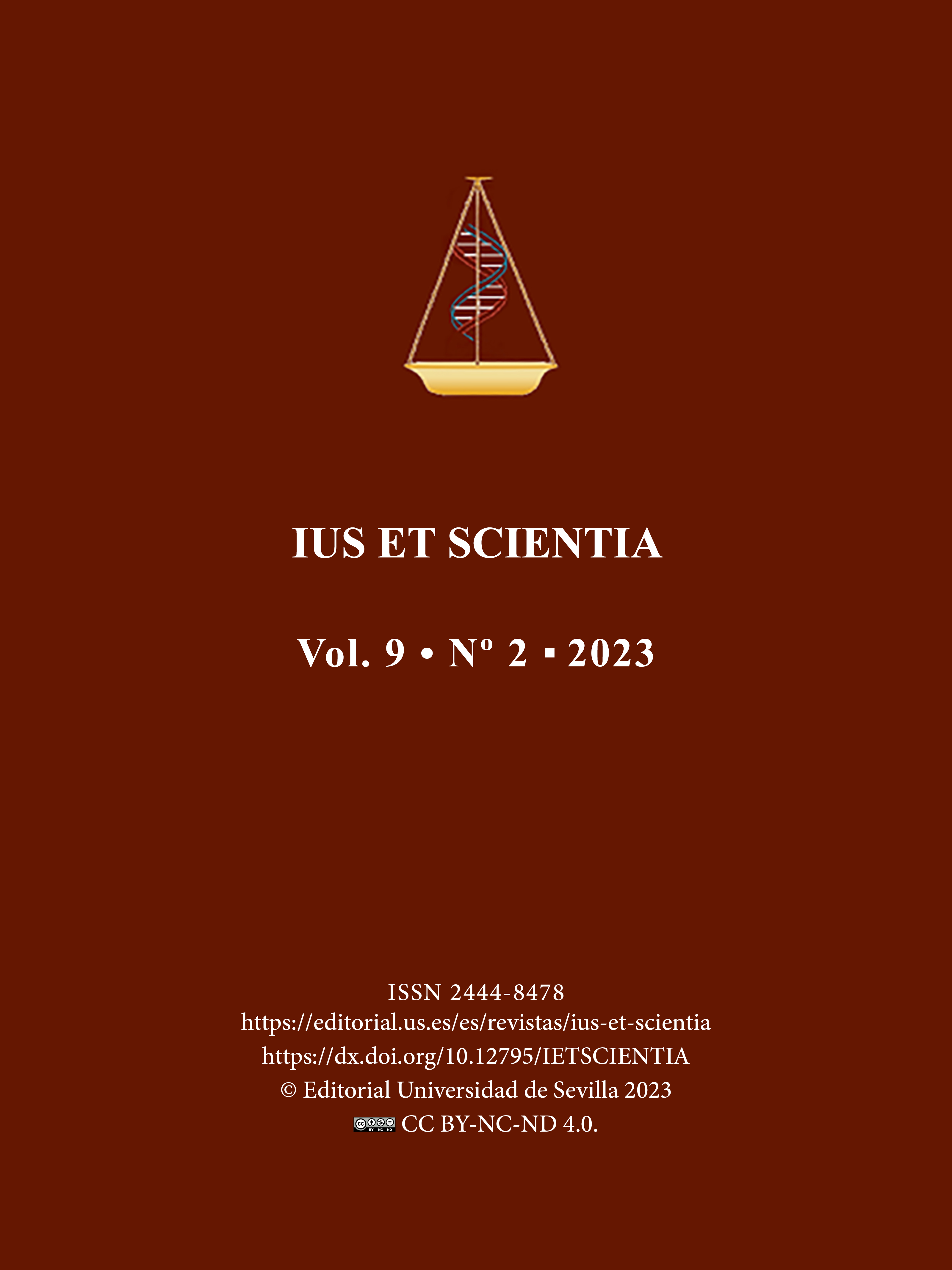The MiCA regulation: liability and sanction for non-compliance on market in crypto-assets regulation
DOI:
https://doi.org/10.12795/IESTSCIENTIA.2023.i02.04Keywords:
Cripto-assets, Digital financial market, Financial crime, Criminal liabilityAbstract
Crypto-assets have become a means of financing within the single market and although their use is still limited, an exponential increase in their applications is expected. They also incorporate, due to their digital nature, a clear transnational projection that is connatural to their nature, which requires convergence between the Union and other international systems, bodies and organisations in order to prevent a lack of investor confidence and prevent the instability resulting from the regulations that have existed up to now
The MiCA Regulation aims to regulate so-called unregulated assets, classifying them according to the risk they entail and instituting a trading infrastructure, which is based on a sanctioning regime for compliance with the obligations imposed on service providers. However, it is necessary to distinguish between the sanctioning functions for non-compliance and the criminalisation of conduct.
Downloads
References
ABEN, J. (2022). “Regulación de las Fintech en la Unión Europea: tendencias y líneas difusas”, Revista CIDOB d’Afers Internacionals, 131, 95-114. http://doi.org/10.24241/rcai.2022.131.2.95 (último acceso 17 de octubre de 2023)
ALVARADO HERRERA, L. (2022). “Los criptoactivos con función de pago: criptomonedas estables y sistemas de pago a la luz de la propuesta del reglamento relativo a los mercados de criptoactivos (MICA)” en M.J. BLANCO SÁNCHEZ y A. MADRID PARRA (Dirs.), Derecho digital y nuevas tecnologías (pp. 857-888). Ed. Thomsom-Reuters Aranzadi
BARRIO ANDRÉS, M. (2022). “La nueva regulación de los criptoactivos en España”, Diario La Ley, 10010. https://diariolaley.laleynext.es/Content/Documento.aspx?params=H4sIAAAAAAAEAMtMSbF1CTEAAmMTC0sTY7Wy1KLizPw8WyMDIyAyMFfLy09JDXFxti3NS0lNy8xLTQEpyUyrdMlPDqksSLVNS8wpTlVLTcrPz0YxKR5mAgCzphe8YwAAAA==WKE (último acceso 1 de octubre de 2023)
CHIU, I. H-Y. (2021). Regulating the Cripto Economy. Business transformation and financialisation, Hart Publishing
GÓMEZ TOMILLO, M. (2022). “Los derechos a no declarar contra sí mismo, a no declararse culpable y a guardar silencio en procedimientos de inspección o supervisión administrativa previos a un procedimiento sancionador o penal”, Estudios penales y criminológicos, 42, 1-31. https://doi.org/10.15304/epc.42.8069 (último acceso 1 de octubre de 2023)
GONÇALVES, DA COSTA VALE, M.L. (2023). A tributação dos criptoativos em Portugal (Impostos sobre o rendimento), https://estudogeral.uc.pt/retrieve/263916/A%20tributac%CC%A7a%CC%83o%20dos%20Criptoativos_M%C2%AA%20Leonor%20Gonc%CC%A7alves.pdf (último acceso 27 de octubre de 2023)
JARNE MUÑOZ, P. (2018). “La Unión Europea ante el reto de las fintech. Algunas notas al Plan de acción en materia de tecnología financiera”, Revista de Estudios Europeos, 72, 118-128. https://dialnet.unirioja.es/servlet/articulo?codigo=6862732 (último acceso 1 de octubre de 2023).
HUANG, S. (2021). “Cryptocurrencies and Crime” en A. LUI & N. RAYDER (Eds.), FinTech, Artificial Intelligence and the Law: Regulation and crime Prevention (pp. 125-143). Routledge, Taylor & Francis Group
KAPSIS, I. (2021). “Should we trade market stability for more financial inclusion? The case of crypto-assets regulation in EU”, en A. LUI & N. RAYDER (Eds.), FinTech, Artificial Intelligence and the Law: Regulation and crime Prevention, Routledge (pp. 85-104). Taylor & Francis Group
MARTÍN RÍOS, P. (2020). “Problemas de admisibilidad de la prueba obtenida de dispositivos de almacenamiento digital”, Revista General de Derecho Procesal, 51, 1-31. https://www-iustel-com.eu.1.proxy.openathens.net//v2//revistas/detalle_revista.asp?id=9 &numero=51 (último acceso 17 de octubre de 2023)
MAUME, P. (2022). “Consumer Protection”, en Maume/Maute/Fromberger (Dirs.), The law of crypto assets. A handbook (pp. 109-120). Beck-Nomos-Hart Ed.
NAVARRO CARDOSO, F. (2019). “Criptomonedas, (en especial, bitcoin) y blanqueo de dinero”, Revista Electrónica de Ciencia Penal y Criminología, 21(14), 1-45. http://criminet.ugr.es/recpc/21/recpc21-14.pdf (último acceso 16 de octubre de 2023)
PARRONDO, L. (2023). “El Reglamento de Mercados de Criptoactivos (MiCA)”, Técnica contable y financiera, 67, 1-10. https://www.academia.edu/106860564/El_Reglamento_de_Mercados_en_Criptoactivos (último acceso 1 de octubre de 2017)
PATZ, A. y WETTLAUFER, I.M. (2022). “E-money Tokens, Ttablecoins and Token Payment Services” en Maume/Maute/Fromberger (Dirs.), The law of crypto assets. A handbook (pp. 242-268). Beck-Nomos-Hart Ed.
PÉREZ LÓPEZ, X. (2019). “Las criptomonedas: consideraciones generales y empleo de las criptomonedas con fines de blanqueo” en D. Fernández Bermejo (Dir.), Blanqueo de capitales y TIC: marco jurídico nacional y europeo, modus operandi y criptomonedas. Ciberlaundry. Informe de situación (pp. 71-147). Ed., Thomson Reuters-Aranzadi
PÉREZ MARÍN, M.A. (2022). “La función preventiva del sistema financiero en el espacio judicial europeo: ¿Medidas (Penales) de Prima Ratio? Revista Internacional CONSINTER de Direito, 8 (14), 289-311. https://revistaconsinter.com/index.php/ojs/article/view/48/80 (último acceso 17 octubre de 2023)
PÉREZ MARÍN, M.A. (2021). “El control de las vías financieras frente a la delincuencia organizada en el espacio de libertad, seguridad y justicia: los avances hacia la persecución de nuevas amenazas” en F.J. Garrido Carrillo (Dir.), Retos en la lucha contra la delincuencia organizada. Un estudio multidisciplinar: garantías, instrumentos y control de los beneficios económicos (pp. 85-119). Ed. Aranzadi
PICÓN ARRANZ, A. (2022). “El derecho a la no autoincriminación en el procedimiento administrativo sancionador: un estudio a la luz de la jurisprudencia del TJUE”. Revista de Estudios Europeos, 79, 367-388. https://doi.org/10.24197/ree.79.2022.367-388 (último acceso 1 de octubre de 2023)
ZARAGOZA TEJADA, J. I. (2019). “Criptoactivo y blanqueo de capitales. Problemas jurídico procesales”, Revista Aranzadi Doctrinal, 8. https://www.thomsonreuters.es/es/tienda/revistas/revista-aranzadi-doctrinal.html (último acceso 17 de octubre de 2023)
Published
How to Cite
Issue
Section
License
Copyright (c) 2023 MARIA ANGELES PEREZ MARIN

This work is licensed under a Creative Commons Attribution-NonCommercial-ShareAlike 4.0 International License.
Those authors being published in this journal agree to the following terms:
- Authors retain their copyright and they will guarantee to the journal the right of first publication of their work, which will be simultaneously subject to license recognition by Creative Commons that allows others to share such work provided it is stated the author’s name and his first publishing in IUS ET SCIENTIA.
- Authors may take other non-exclusive distribution license agreements version of the published work (e.g. deposit in an institutional digital file or publish it in a monographic volume) provided it is stated the initial publication in this journal.
- It is allowed and encouraged that Author s disseminate their work via the Internet (e. g. institutional digital files or on their website) prior to and during the submission process, which can lead to interesting exchanges and to increase citation of the published work.
- Abstract 560
- PDF (Español (España)) 460
- HTML (Español (España)) 263





